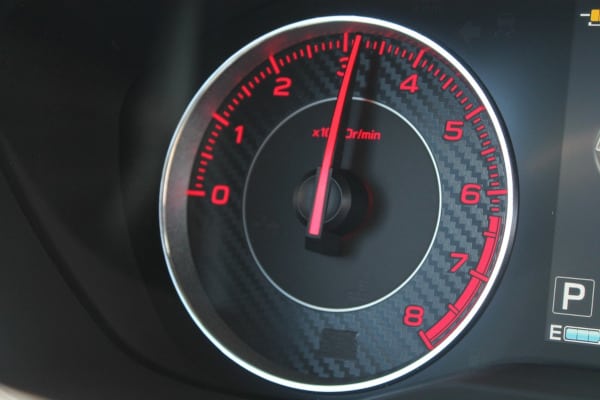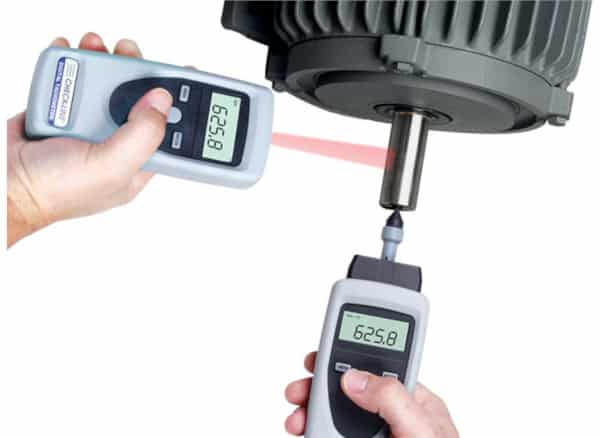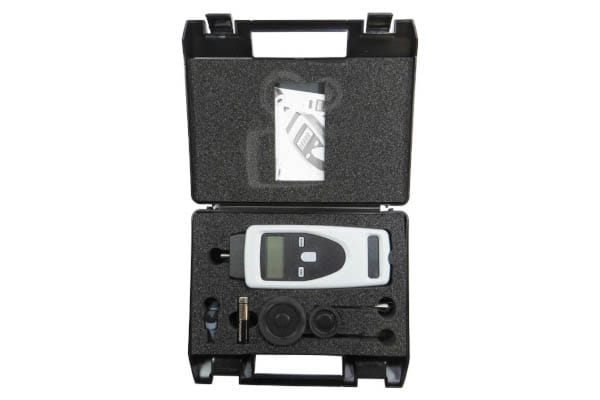Handheld digital tachometers offer precise measurements of rotational speed
Tachometers measure how quickly something spins, and today’s digital tachometers can do it with unmatched accuracy, precision, and ease of use. In this article, we’ll talk about handheld tachometers, explaining the difference between contact and non-contact tachometers and looking at the features of today’s digital tachometers.
Need to shop for one now? Click here to check out our 809 test kit which includes a handheld digital tachometer.
Handheld tachometers provide measurements of rotational speed in a wide range of applications
In the most basic sense, a tachometer is a counting device. This tool counts how quickly a rotating object completes a full spin. Tachometers then use this count to measure that object’s rotational speed. Tachometers are everywhere: nearly every car, boat, or airplane has a tachometer to provide drivers with a sense of engine speeds. Most tachometers display that speed as revolutions per minute, or RPM.
Handheld tachometers are most commonly used to determine the speed and RPMs of small motors, engines, gears, or fans. However, the versatility of the device is considerably greater. A digital tachometer can be used to calibrate larger tachometers used with aircraft and motor vehicles. They can also measure the RPM of lawn mower blades, industrial printers, machine lathes, generators, and boat propellers.

Contact and non-contact tachometers measure RPM in slightly different ways

Contact tachometers have a tip, usually called an adapter, that rests against the spinning object. The adapter spins with the machine to calculate the RPM of the spinning object.

Contact tachometers may not work well with some objects. When equipment is hard to reach—such as machinery within cages or behind protective equipment—a contact tachometer may prove impractical.
But some tachometers can measure revolutions per minute without touching the spinning surface. A non-contact tachometer—also known as a photo-tachometer or non-touch tachometer—uses a laser, infrared light, or another light source to take measurements.

When using a non-contact handheld tachometer, a reflective mark is placed on the spinning object. A paint marker or strip of reflective tape can work, provided that the rest of the surface has a dark or otherwise non-reflective surface.
A non-contact tachometer sends out a beam of light. That beam reflects each time the tape or reflective mark makes a full rotation. The receiver counts these reflections over time to display the rotational speed in revolutions per minute.
While a wide variety of handheld tachometers exist, some features and components can greatly improve usability
A wide variety of tachometers exist to serve different needs. Analog tachometers provide immediate readouts using a dial. Digital tachometers display readings on an LCD or LED screen. Digital models can often save measurements to memory, helping users keep their measurements organized and limiting the need to measure a second time.
More advanced digital tachometers offer versatility that simpler models or analog tachometers can’t. Digital tachometers can convert RPM readings into other measurements, like feet per second. High-resolution digital tachometers also provide extreme precision and accuracy. Some measure RPM to a hundredth of a rotation with a barely-recognizable margin of error. For high-precision applications, some manufacturers provide in-house or laboratory calibration to the standards of the National Institute of Standards and Technology, or NIST.
Adapter durability can make or break a contact tachometer. Many inexpensive handheld tachometers feature low-quality rubber adapters that wear out quickly.
Some users find that non-contact tachometers with visible light, rather than infrared, make it easier to properly aim the tachometer at a distance. Every tachometer needs enough reflective material—again, markers, tape, or whatever the manufacturer recommends—to take plenty of measurements.
Finally, because rotating devices are not always accessible—and because getting these measurements may take some time—lightweight tachometers can significantly improve ease of use.
Checkline handheld digital tachometers provide precision, ease of use, and contact and non-contact functionality
Checkline digital handheld tachometers make taking contact or non-contact readings easy. Made by Electromatic Equipment Company, a German manufacturer with six decades in the industrial measuring industry, Checkline tachometers offer portability, precision, and accuracy in a wide range of applications.

Their Checkline CDT 2000 HD model weighs only 6 ounces and measures only 8 3/8″ x 2 5/8″ x 1 1/4″ with the tip attached (or 6″ long without). This digital tachometer produces readings as fine as .01 RPM for devices spinning below 100 RPM, .1 RPM for speeds between 100-1000 RPM, and 1 RPM for speeds between 1000 and 99,999 RPM. And this device is accurate to 0.02%.
With a visible LED light beam and a sensing distance up to 24 inches, this digital tachometer is perfect for non-contact applications. The included cone tip and wheel contact adapters can measure at the end of a shaft or perpendicular to the rotating object.

Checkline CDT 2000 HD comes as a kit with a slide-in contact adapter, 6” and 0.1-meter surface speed wheels, cone tip, funnel tip, extension shaft, reflective tape, two AA batteries (1.5 V), calibration certificate, and operating instruction manual all packaged nicely within a durable carrying case.
Click here to check out our 809 Fire Pump Test Kit which includes the Checkline Tachometer.
Questions about our handheld digital tachometers? Call us at +1 (888) 361-6662 or email support@qrfs.com.
This blog was originally posted by Jason Hugo at blog.qrfs.com on July 16, 2017, and updated on February 12, 2019. If this article helped you find the tachometer you needed, check us out at Facebook.com/QuickResponseFireSupply or on Twitter @QuickResponseFS.



Please let me know if you can supply the following item:
Digital Tachometer
Model CDT 2000HD
We are based in Cebu Philippines
Kenneth, we do have the Model CDT 2000 HD Digital Tachometer. This is available for purchase online. You can contact support@qrfs.com for more information!